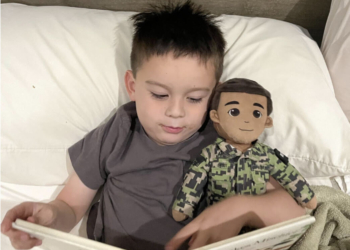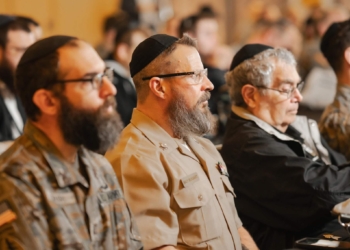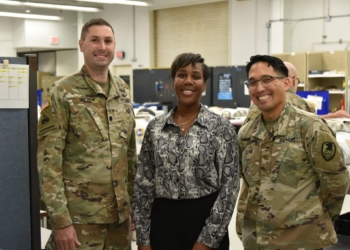What happens beyond the “happily ever after” of military love stories? First comes love, then comes marriage, then comes a carousel of blissful homecoming photos. But what many people don’t talk about is the reintegration of a service member returning home.
As of December 2011, the RAND Corporation states that roughly 73% of soldiers had deployed to Iraq and Afghanistan. That does not also take into account additional work-ups or temporary duty assignments. So, then, how do military couples attempt to establish a sense of normal when one of them is gone from home more often than not?
Meet the Benkos

Staff Sgt. (select) Alex Benko and his wife, Samantha, were married on July 29, 2017. In the honeymoon years of their marriage, Alex Benko deployed to the Middle East as a combat controller. At home at Cannon Air Force Base, New Mexico, Samantha Benko created a new normal by establishing herself as a virtual health and wellness coach. When Alex Benko returned six months later, his wife had established a new routine and identity.
Through all the excitement of him returning, though, it was easy for them to overlook that they would have to merge new patterns they created while apart.
“You go through just being so excited that they’re finally home, and it almost feels surreal because you spend half a year or more looking forward to that day, and it’s finally here,” Samantha Benko explained. “It’s almost like you’re so excited to see them, but then real life just steps back in. … It’s almost like a letdown when it has to go back to real-life so quickly.”
The couple attributes their success of reintegrating back together to being supportive of each other growing as individuals outside of their marriage. Alex Benko especially likes that his spouse found a purpose beyond their relationship, especially since she gave up teaching third grade in order to be with him.
“That kind of helped her grow as an individual even while I was gone, and now she’s still continuing to grow in that, which is super great to see. … Discovering that throughout deployment has kind of helped her, especially, realize that she can still be very much fulfilled while I’m gone,” Alex Benko said.
The staff sergeant is often gone from home because his job requires travel for training. Therefore, his erratic home-life schedule is something they have accepted as normal, even if their definition of it doesn’t match others.
“I think normal is what you want it to be,” Alex Benko explained. “We strive for certain things in our marriage. We strive to communicate so when we’re not communicating, that’s abnormal for us. We strive to spend time together, to grow in one way or another. And that is normal for us. So, when we’re not growing, when we’re not progressing on in our relationship with each other, our relationship with God, that’s not normal for us.”
Yet in their own sense of normal, they have needed to spend time learning how to function as one. Among many things, Samantha Benko says she has adjusted to not having the house organized and cleaned to exactly her standards, and has needed to accept that there are more groceries to buy and loads of laundry to do. Ultimately, they needed to synthesize their lives again.
“Being separated for six months and being pretty independent people even when we are together, we have a hard time talking about finances and budget, because he was gone for six months and we just kind of did our own thing,” Samantha Benko added. “So that was definitely him coming back home and realizing OK, we’re a team on this. This isn’t I do what I want, you do what you want.”
Alex Benko admits the hardest part of reintegrating after deployment is learning how to be married again.
Transforming a marriage
Military and first responder clinical consultant Corie Weathers, who is also a military spouse and host of the Lifegiver Podcast, states that the hardest part of reintegration for military couples is the merging of new patterns. While apart, couples carve different paths into their daily lives than when they are together.
“It’s almost like when you carve into wood a circle, right?” Weathers said. “The more you’re going around in that circle, the deeper the groove gets. And you don’t even realize that’s what you’re doing. The longer the deployment, the deeper that groove gets.”
As unromantic as it may be, Weathers suggests couples do their own version of a mission brief. In much the same way that troops prepare for deployment, couples should have a sit-down about the reverse in coming home.
“We need to apply that to marriages, too, and not think that we are going to cause conflict or hurt each other’s feelings because things have changed,” she said. “So just sitting down and communicating to each other, and go ‘here’s what’s new, here’s what’s different, here’s how I’m different.’ … If we can proactively have that conversation, then when it happens, we’re less likely to have conflict.”
The Benko’s success in transforming their independent circles into an infinity circle is through communication. Every Sunday, they ask each other four questions in order to set up realistic expectations of each other.
“Expectation management is everything,” Alex Benko said. “It’s not just realizing that it’s going to be awesome all the time. It’ll be awesome, but not all the time. And you will have troubles going through your goals, or your two-year goals. Expecting that and realizing that is super key so you don’t end up just getting super frustrated with each other.”
Weathers doesn’t think people should dismiss the honeymoon period of a homecoming. She says to enjoy it, embrace the emotions of it and spend time to reconnect. But when the newness and excitement starts to fade away, it’s important to set each other up for success and future wins in their relationship.
“It’s just communicating three things that you need your spouse to know so that they can get it right with you,” Weathers said.
She adds that people shouldn’t be afraid to get help in communicating, whether it is with a chaplain or counselor, or using a journal to prompt conversation. She adds that couples should know that the counseling through TRICARE does not require a referral, and the spouse can use their name for confidentiality.
Corie Weathers’ top three resources for additional help in communicating:
Listen to the Lifegiver Podcast.
Weathers hosts a weekly podcast that “breathes life into your marriage.” She interviews families, authors and fellow clinicians about all-things relationships. It’s her way of encouraging couples during anything they are going through in their marriage.
Take the “Better Love” relationship assessment.
The quick assessment of a couple’s relationship helps examine where they have conflict and where they excel at things together. Weathers says it helps provide a brief snapshot of where the couple is and provides an easier way to talk.
Complete the “How to Love Me” relationship journal.
What Weathers refers to as a “little black book,” the questionnaire is filled with fun-to-deep topics that help couples learn more about one another. She suggests completing it over the course of a deployment, and trading it at the end to read about one each other.
Read comments






































